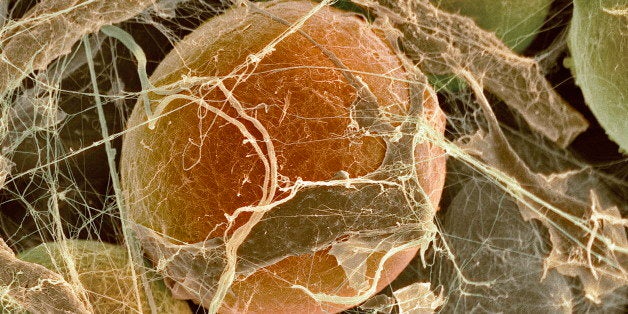
What if you could trick your body into thinking you were racing on a treadmill—and burning off calories at a rapid clip—while simply walking down the street? Changing our rate of energy expenditure is still far into the future, but work in mice explores how this might happen. Two teams of scientists suggest that activating immune cells in fat can convert the tissue from a type of fat that stores energy to one that burns it, opening up potential new therapies for obesity and diabetes.
There are two types of fat in humans: white adipose tissue, which makes up nearly all the fat in adults, and brown adipose tissue, which is found in babies but disappears as they age. Brown fat protects against the cold (it’s also common in animals that hibernate), and researchers have found that mice exposed to cold show a temporary “browning” of some of their white fat. The same effect occurred in preliminary studies of people, where the browning—which creates a tissue known as beige fat—helps generate heat and burn calories. But cold is “the only stimulus we know that can increase beige fat mass or brown fat mass,” says Ajay Chawla, a physiologist at the University of California (UC), San Francisco. He wanted to better understand how cold caused this change in the tissue and whether there was a way to mimic cold and induce browning some other way.
A few years ago, Chawla’s group had reported that cold exposure activated macrophages, a type of immune cell, in white adipose tissue. To further untangle what was going on, Chawla, his postdoc Yifu Qiu, and their colleagues used mice that lacked interleukin-4 (IL-4) and interleukin-13, proteins that help activate macrophages. When they exposed these mice to the cold, the animals developed far fewer beige fat cells than did normal animals, suggesting that macrophages were key to browning of white fat.
But could giving IL-4 to healthy mice, housed in temperate conditions, create more beige fat? That was the big question, and Chawla’s group found that the answer was yes. Animals living at a comfortable 30°C received IL-4. Levels of a protein that helps the body produce heat, and that’s expressed in beige fat, soared 15-fold, and the animals’ energy expenditure increased by 15% to 20%—just as if they were sitting in a chilly cage.
Across the country, cell biologist and biochemist Bruce Spiegelman and his former postdoctoral fellow Rajesh Rao, both at Harvard Medical School’s Dana-Farber Cancer Institute in Boston, were independently probing the browning of mouse fat. Spiegelman’s group had previously found that when a protein called PGC-1 was produced in muscles, it prompted adipose tissue to brown. He wanted to find the missing link, whatever PGC-1 was triggering, which in turn more directly affected fat. Spiegelman’s team analyzed genes and proteins that were switched on in fat when PGC-1 was expressed in muscle, and they saw that one gene stood out.
The gene produced a hormone called meteorin-like, or Metrnl, that’s induced in muscle after exercise and also with cold exposure. The scientists found that it also browns white fat in mice. Mice given gene therapy that boosted production of Metrnl had better glucose tolerance, suggesting an antidiabetic effect, and lost a small amount of weight. Consistent with the San Francisco team’s work, Metrnl increased the numbers of certain types of macrophages and the amount of IL-4 in the fat tissue. Giving mice an antibody that neutralizes Metrnl left them with a defective response to the cold; they failed to activate the macrophage genes needed to brown their fat. “It’s thrilling the way it worked out,” Spiegelman says of both his and Chawla’s work, which appear today in Cell.
“This mechanism for basically inducing these brown or beige fat cells … wasn’t previously recognized,” says Patrick Seale, a molecular metabolism expert at the University of Pennsylvania. Metrnl, Seale notes, “really hasn’t been described before—just giving animals this one protein is capable of inducing this browning response” which is “pretty exciting.” And that in turn opens up some intriguing possibilities for treating obesity and diabetes, such as giving a therapy like Metrnl, if it turns out to be safe and effective, that can brown white fat.
“The idea that you could pharmacologically manipulate a person’s energy expenditure,” by browning their white fat, “is certainly an attractive idea, and it’s a different way of thinking about obesity,” says Peter Tontonoz, who studies molecular metabolism at UC Los Angeles. How this process works in people is still unknown. But scientists are thinking ahead. Spiegelman, for example, co-founded a company, Ember Therapeutics, that is trying to commercialize the work.
Original article:
This story has been provided by AAAS, the non-profit science society, and its international journal, Science.